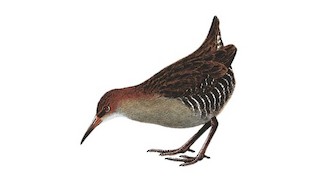Auckland Islands Rail Lewinia muelleri Scientific name definitions
- VU Vulnerable
- Names (24)
- Monotypic
Text last updated June 21, 2016
Sign in to see your badges
Species names in all available languages
| Language | Common name |
|---|---|
| Bulgarian | Оукландски дърдавец |
| Catalan | rascló de les Auckland |
| Croatian | oklandska kokošica |
| Czech | chřástal aucklandský |
| Dutch | Müllerral |
| English | Auckland Islands Rail |
| English (New Zealand) | Auckland Island Rail |
| English (United States) | Auckland Islands Rail |
| Estonian | motumaha väikeruik |
| Finnish | aucklandinluhtakana |
| French | Râle des Auckland |
| French (Canada) | Râle des Auckland |
| German | Aucklandralle |
| Japanese | オークランドクイナ |
| Norwegian | aucklandrikse |
| Polish | wodnik maoryski |
| Russian | Оклендский пастушок |
| Serbian | Oklandski petlovan |
| Slovak | chriašteľ aucklandský |
| Spanish | Rascón de las Auckland |
| Spanish (Spain) | Rascón de las Auckland |
| Swedish | aucklandrall |
| Turkish | Aukland Sukılavuzu |
| Ukrainian | Левинія маорійська |
Lewinia muelleri (Rothschild, 1893)
Definitions
- LEWINIA
- muelleri
The Key to Scientific Names
Legend Overview
Field Identification
Systematics History
Subspecies
Distribution
Aucklands Is (Disappointment I and Adams I), S of New Zealand.
Habitat
Frequents herbaceous vegetation on damp to wet, flat to steeply sloping ground with clear areas at ground level and dense canopy c. 1m above. Occurs in herb fields with megaherbs and sedges, and grasslands with sedges, ferns, low woody shrubs and tussocks; also ventures into scrubby forest with 2·5 m high canopy and 1m sub-canopy over dense patches of grass and sedge. Occurs from sea-level to 500 m.
Movement
Diet and Foraging
Sounds and Vocal Behavior
Breeding
Season probably Oct–Dec. Probably monogamous and territorial. Two nests described: both in wetlands, in tussocks of Carex appressa and Chionochloa antarctica, sheltered by overhanging or interlaced vegetation and with well defined entrance runway. Nest a shallow cup of grasses and/or sedges; external diameter 14–23 cm and depth 7–16 cm; internal diameter 7 cm and depth 2–7 cm; cup 13–15 cm above ground. One clutch of 2 eggs recorded; incubation period probably similar to that of L. pectoralis; downy young not described.
Conservation Status
VULNERABLE. Probably eliminated on Auckland I by feral cats and/or pigs in 1860s, and thought to be extinct on other islands until a population of several hundred was discovered on Adams I (10,000 ha) in 1989, and one of c. 500 on Disappointment I (280 ha) in 1993. Only 10% of Adams I comprises suitable habitat (1); population said to be 1500 birds (2). May still occur on other islands. These islands are part of the Auckland Islands Nature Reserve and access is strictly controlled; survival of species depends on the continued exclusion of mammalian predators, especially rats, cats and pigs. Adams I has no introduced mammals but has New Zealand Falcons (Falco novaeseelandiae), which commonly predate rails (3); Brown Skuas (Catharacta antarctica) are further possible predators. Auckland I (a few hundred metres from Adams I) has populations of feral cats, mice and pigs, which should be eliminated in order to avoid inadvertent introduction.

- Year-round
- Migration
- Breeding
- Non-Breeding









































